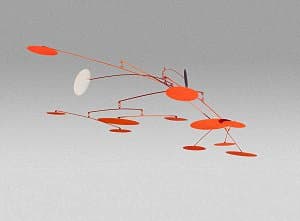

Alexander Calder
Learn moreNight and day 1964
© Calder Foundation, New York/Copyright Agency Purchased 1978
More detail | PermalinkWhy must art be static? You look at an abstraction, sculptured or painted, an entirely exciting arrangement of planes, spheres, nuclei, entirely without meaning. It would be perfect but it is always still. The next step is sculpture in motion.[1]
Alexander Calder’s Night and day 1964 is one of a group of sculptures with moving elements, called ‘mobiles’. These works combine the artist’s interests in abstraction, physics, engineering and astronomy with his intrinsic sense of playfulness. Trained in mechanical engineering and applied kinetics, Calder first exhibited his mobile works at the Galerie Vignon, Paris, in 1932. The term ‘mobile’ was coined by fellow artist Marcel Duchamp: meaning not only something that moves, but in French also ‘motive’. The first mobiles were motorised, but later Calder adapted the construction to allow free-floating movement, simply powered by air currents: ‘Each element able to move, to stir, to oscillate, to come and go in its relationships with the other elements in its universe.’[2]
The colour and composition of Piet Mondrian’s abstract paintings inspired the mobiles. Describing his own use of colour, Calder noted: ‘I have chiefly limited myself to the use of black and white as being the most disparate colours. Red is the colour most opposed to these ...’[3] Night and day consists of 10 flat red discs hanging horizontally from a series of loosely connected cross bars, with two additional vertical discs—one black and one white—facing each other. This combination is found not only in Night and day, but in many other closely associated works.[4]
Despite the intrinsic abstraction of his mobiles, Calder acknowledged the influences of astronomy on his practice:
the underlying sense of form in my work has been the system of the Universe ... the idea of detached bodies floating in space, of different sizes and densities, perhaps of different colours … and some at rest, while others move in peculiar manners, seems to me the ideal source of form.[5]
In addition, the artist has described an experience in 1922 where he woke to ‘the beginning of a fiery red sunrise on one side and the moon looking like a silver coin on the other … it left me with a lasting impression of the solar system’.[6] This not only influenced the wider series but has particular relevance to Night and day, with the white and black facing discs representing the celestial dualities of the title.
Simeran Maxwell
[1] Alexander Calder, ‘Objects to art being static, so he keeps it in motion’, New York World-Telegram, 11 June 1932.
[2] Achim Borchardt-Hume (ed), Alexander Calder: performing sculpture, Tate Publishing, London, 2015, p 219.
[3] Jean Lipman, Calder's universe, Viking Press, New York, 1976, p 33.
[4] Similarly constructed and scaled, Black, white, and ten red 1957 (National Gallery of Art, Washington DC) can be seen as a precursor to the more evocatively titled Night and day.
[5] Alexander Calder, ‘What Abstract Art means to me?’, in Museum of Modern Art Bulletin, vol 18, no 3, Spring 1951, p 8.
[6] Alexander Calder, Calder: An autobiography with pictures, Pantheon Books, New York, 1966, pp 54–5.

